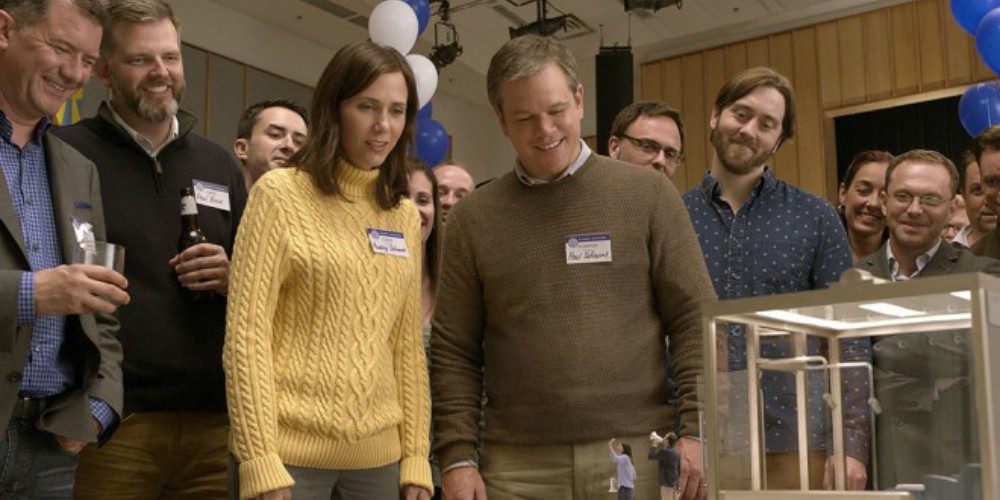Would you shrink down to the size of a saltine cracker to live a life of opulence? That seems to be the central question asked and answered in Alexander Payne’s end of 2017 film Downsizing, though it actually doesn’t end up being what the film is about at all. While the concept briefly explored in Downsizing is intriguing, the film ultimately misses the mark by abandoning its central premise to retell the same movie we’ve seen over and over of a middle-aged white guy having a crisis and learning a set of life lessons by re-discovering himself. How disappointing.
The premise to downsizing is right in the title. In the near future, Scandinavian scientists have developed a safe process to shrink human beings to just a few inches tall. It is developed as a way to reduce humanity’s consumption and save the planet, and is sold as a way to live out a life of luxury given how cheap travel and goods are for people 2,700% smaller than the rest of us. But this is pretty much where the concept falls away. Significant time is spent (and arguably wasted) explaining the process of downsizing and expositing everything we need to know before it’s all discarded anyway and a whole new, very different movie begins.
Matt Damon plays Paul Safranik, a middle class, middle-aged man married for a few years and living in the Midwest (Omaha, Nebraska, to be precise). Paul is reasonably successful, living as an occupational therapist who gave up on his dream of being a doctor to help his sick mother. He’s initially sold on the idea of downsizing as a way to help the planet, but when he finds out the luxurious lifestyle he can lead despite his relatively meager middle-class net worth, he’s ready to go all the way, and drag his hesitant wife, Audrey (Kristen Wiig) along for the ride. The audience is walked through the process of downsizing, but we quickly find out afterwards that Audrey’s second thoughts finally got the better of her and she backs out of the process, leaving tiny Paul alone in their pint-sized mansion.
Here the film jettisons the concept of downsizing and focuses on Paul’s mid-life crisis. Newly divorced, working at a Land’s End call center, and generally dissatisfied with his new life, Paul muddles through day by day in a much less satisfying monotony than the one he left. A chance encounter with his neighbor and his neighbor’s cleaning lady sends him on a voyage of self-discovery, blah blah blah. Nothing after that really matters because the film retreats from its premise so sharply to pursue an uninspired, boring, recycled, way too lengthy Acts II and III. If this was the movie they wanted to make, they should have deleted the whole downsizing concept, and, ahem, downsized about 45 minutes of the movie, made Paul a Land’s End call center worker after a divorce and start there.
I already saw Brad’s Status earlier this year, and frankly we don’t need more than one male white guy midlife crisis movie a year. Splicing in Honey I Shrunk the Kids as nothing more than an occasional laugh line only served up disappointment, as I felt like the excellent premise had so much more potential. The film very, very briefly explores a character who was forcibly downsized in Vietnam as a political prisoner to silence her voice. But ultimately her character is merely a foil for Paul and a joke machine for cheap laughs from her broken English. The movie left me feeling unfulfilled, bored, and fantasizing about what they could have done with this if they’d embraced the concept as the centerpiece of the show rather than as set dressing.
What if the main couple were elderly, and America decided to solve the problem of an aging, expensive population by downsizing everyone when they reach the age of 70? Now all our elderly can live in comfort, with medical expenses covered easily and a life of leisure for all. Solves one problem, right? But what about grandparents bouncing grandchildren on their knees? What about spending time with them? Or does this just let us dump them somewhere? It opens up a host of interesting moral questions. Or what if everyone was downsized and the company all those folks invested their money in went bankrupt, what happens to all those people? How about a world where criminals are downsized against their will to make the problem more manageable? With the process being irreversible, would that create an oversized ex-convict population and how moral would it be to force that on them? Or how about all these things in a single film that puts the focus on the side effects of a society heavily invested in Lilliputian technology.
The premise was exciting enough to bring people to the theater. But I didn’t much know what to make of the film’s message. Is it that people should be content with what they have? The grass isn’t always greener on the other side? That we should enjoy the time we have left? That life is more rewarding when you’re helping those less fortunate rather than walling yourselves off from them? Is downsizing a metaphorical critique of materialism? Or is there no message, and that’s just me reaching for an explanation on why I just wasted two and half hours of my life.
Ironically, Alexander Payne’s failure here was in simply thinking too small. I hope someone picks up the baton and takes a chance on another version of this that takes more risks and fully commits to the idea of downsizing. Futuristic dystopias are perhaps just as much of a fad as midlife crisis films, but cinema that explores moral questions, stretching the fabric of society and exploring humanity are timeless, always ripe for picking, and never go out of style.








